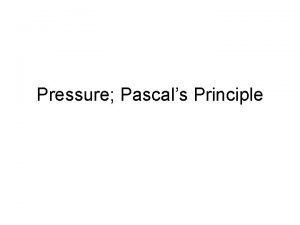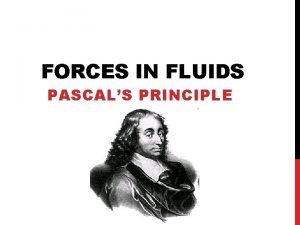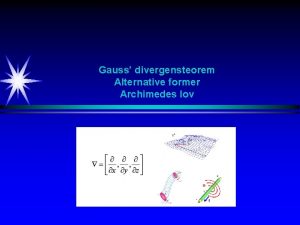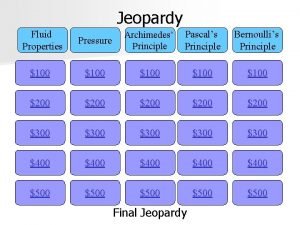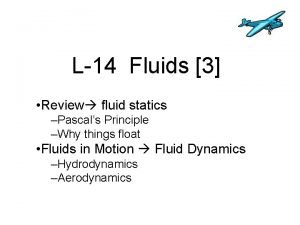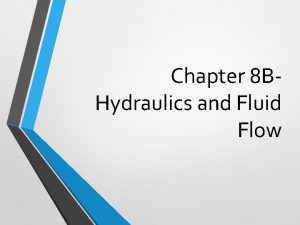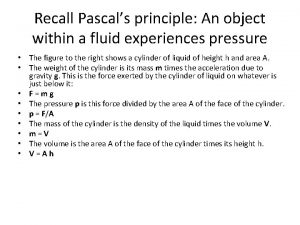Pascals Principle What happens inside a fluid when














- Slides: 14

Pascal’s Principle Ø What happens inside a fluid when pressure is exerted on it? Ø Does pressure have a direction? Ø Does it transmit a force to the walls or bottom of a container? Any change in the pressure of a fluid is transmitted uniformly in all directions throughout the fluid.

Boyle’s Law • Boyle discovered that the volume of a gas is inversely proportional to the pressure. • Boyle’s Law: PV = constant – When temperature is contant. – PV = nk. T – P = (n/V)k. T. • Number Density = n/V • If the pressure increases, the volume decreases. • P 1 V 1 = P 2 V 2 • At higher altitude, the air density become smaller, i. e. larger volume, the air pressure become smaller. – This is the reason of the balloon inflation.

2 A-03 Vacuum Demos Effects of Vacuum on objects made largely of air or air pockets. Why do the balloons burst in the vacuum ? Why do the marshmallows get bigger in vacuum ? Do the balloons burst in vacuum differently then they normally burst ? What will happen when the marshmallows are returned to normal pressure ? Can you guess what happens when Shaving Cream is placed in vacuum ? 6/5/2021 Physics 214 Fall 2010 3

Q 10 If you climbed a mountain carrying a mercury barometer, would the level of the mercury column in the glass tube of the barometer increase or decrease as you climb the mountain? A. Increase B. Decrease C. Same level The pressure decreases because you have a smaller column of air to support so the height would decrease 6/5/2021 Physics 214 Fall 2010 4

Q 11 If you filled an airtight balloon at the top of a mountain, would the balloon expand or contract as you descend the mountain? A. Contract B. Expand C. Unchanged. 6/5/2021 Physics 214 Fall 2010 5

buoyant force • consider a block submerged in water, suspended from a string. – The pressure of the water pushes on the block from all sides. – Because the pressure increases with depth, the pressure at the bottom of the block is greater than at the top. – There is a larger force (F = PA) pushing up at the bottom than there is pushing down at the top. – The difference between these two forces is the buoyant force. F = mg = density*volume*g pressure = F/A = density*g*volume/A =height pressure = density*g*height Pascal’s principle says: density*g*height is the same everywhere and in all directions.

2 B-04 Liquid Pressure Investigating Pressure in different directions within a liquid in equilibrium. What will happen to the reading on the manometer as the sensor is rotated ? The increase in pressure ρgh is measured by the difference in height of the liquid in the U tube. g A B h A B AT ANY GIVEN POINT IN A STATIONARY LIQUID, THE PRESSURE IS THE SAME IN ALL DIRECTIONS. 6/5/2021 Physics 214 Fall 2010 7

Archimedes’ Principle • Archimedes’ Principle: The buoyant force acting on an object fully or partially submerged in a fluid is equal to the weight of the fluid displaced by the object. • pressure = density*g*height • buoyant force = difference between forces on top and bottom surface = (area*density*h)*g = mg = weight of the fluid displaced by the object.

Ch 9 CP 4 Wooden boat: 3 m x 1. 5 m x 1 m that carries five people. Total mass of boat and people equals 1200 kg. What volume of water must be displaced to float and How much of the boat underwater? (hint: H 2 O = 1 g/cm 3) A. B. C. D. 2. 4 m 3, 1. 2 m 3, 3. 6 m 3, 0. 62 m 0. 27 m 0. 1 m 0. 27 m 1. 5 m Fnet = Fb – W = 0 Fb = 11760 N 1 m 3 m W c) Fb = H 2 O Vg (see Ch 9 E 12) Fb/ H 2 Og = 11760 N/(1000 kg/m 3)(9. 8 m/s 2) = V = 1. 2 m 3 d) V = LWh = (3 m)(1. 5 m)h = 1. 2 m 3 6/5/2021 Fb h = 0. 27 m Physics 214 Fall 2010 9

2 B-05 Pressure Forces in Liquids An open ended cylinder kept shut by liquid pressure What happens as the submerged cylinder filled with air is filled with water ? There are two forces acting on the plate. It’s weight down and PA up. When PA exceeds the weight the cylinder stays intact In this situation the plate has to now support the weight of the water and when the weight of the water plus plate exceeds PA the cylinder opens 6/5/2021 Physics 214 Fall 2010 Air PA Water PA 10

2 B-08 Buoyant Force Compare the Buoyant Force between two cylinders of equal volume and different mass. T T Which object experiences the greater buoyant force, the heavier one or lighter one ? FB Mg Scale reads tension in cord: T = Mg – FB Mg = FB + T Mg We find Fb to be exactly equal for both masses BUOYANT FORCE DOES NOT DEPEND ON THE MATERIAL OF THE OBJECT DISPLACING THE FLUID. THE BUOYANT FORCE DEPENDS ONLY ON THE VOLUME OF FLUID DISPLACED. ; 6/5/2021 Physics 214 Fall 2010 11

2 B-10 Archimedes II Take the 1 st reading before put the object into large beaker where the water level is just at the overflow point. One then submerge the object into the water while the displaced water is caught in a small beaker. Take the 2 nd reading on the scale. One then put the overflowed water to the copper container, take the 3 rd reading. The 3 rd reading of the scale will A. Be the same as the 2 nd reading. B. Be the same as the 1 st reading C. Be smaller than the 1 st reading. 6/5/2021 Physics 214 Fall 2010 12

2 B-10 Archimedes II Use a scale to establish the relationship between the Buoyant Force on an object and the Weight of Fluid Displaced by the object T 1 FB B A Mg T 3 T 2 C Mg FB WDF Mg A. The block is not immersed T 1 = Mg B. The block is immersed but the liquid runs out T 2 = Mg – FB C. The displaced liquid is poured into the can T 3 = Mg – FB + WDF T 1 is found to equal T 3 which means that the bouyant force FB is equal to WDF the Weight of the displaced Fluid THE BUOYANT FORCE IS EQUAL TO THE WEIGHT OF THE FLUID DISPLACED. 6/5/2021 Physics 214 Fall 2010 13

Quiz: Boat displaces 2. 5 m 3 of water. Density of water H 2 O = 1000 kg/m 3. What is the mass of water displaced? What is the buoyant force? A). Mass = 2500 kg, buoyant force = 24500 N B). Mass = 250 kg, buoyant force = 2450 N C). Mass = 25 kg, buoyant force = 245 N D). Mass = 2500 kg, buoyant force = 2450 N E). Mass = 2500 kg, buoyant force = 245 N Mass of fluid displaced (m. FD) = volume x density of fluid. MFD = VFD H 2 O = (2. 5 m 3)(1000 kg/m 3) = 2500 kg Buoyant force equals weight of fluid displaced. Fb = WFD = m. FD g = (2500 kg)(9. 8 m/s 2) = 24500 N Fb = WFD 14
 What does pascals law state
What does pascals law state ρhg
ρhg Pascal's identity
Pascal's identity Pascals prinicple
Pascals prinicple Pascals identity
Pascals identity Pascal's triangle hockey stick pattern
Pascal's triangle hockey stick pattern Pascals triangle 8
Pascals triangle 8 Binomial theorem pascal triangle
Binomial theorem pascal triangle Divergensteorem
Divergensteorem How to find pressure potential
How to find pressure potential Interstitial vs intracellular
Interstitial vs intracellular Intracellular extracellular fluid
Intracellular extracellular fluid Fluid statics deals with fluid at rest
Fluid statics deals with fluid at rest Fluid mechanics chapter
Fluid mechanics chapter Fluid statics deals with fluid at rest
Fluid statics deals with fluid at rest

